The waggler is a float that attaches bottom-end only and is cast on rod and line, as opposed to being shipped out on a pole.
In bygone years, waggler fishing was the nation’s number one form of float fishing, though today it is arguably under challenge from pole fishing in terms of popularity. However, research suggests that it’s still the favourite tactic for older anglers.
Drennan-backed England International Steve Hemingray has honed his skills on the waggler for more than 30 years.
Here’s Steve’s essential guide to mastering the waggler. He’ll look first at the kit you need, detail the rigs and then show you how to catch on two types of waggler float.
Weather conditions
Little or no wind and good visibility is perfect for waggler fishing. In these conditions you can use a sensitive waggler float to good effect.
If there is a strong wind blowing you must try to find a peg with the wind coming straight off your back.
If the wind is blowing left to right, or right to left, it will effect your ability to cast and feed accurately, and also drag the float unnaturally across the surface. This is the kiss of death!
Pick a peg with fish-holding features – islands, reeds, lily beds or far bank overhanging trees/bushes – to cast to.
The gear you need...
Rods and reels
The one thing you won’t need for waggler fishing is a rodrest. The idea is to hold the rod throughout the session, so you’re ready to hit lightning bites. The ability to loosefeed by catapult while holding the rod is a huge asset, otherwise you can always sit on the rod butt while feeding, then pick it up quickly.
Because you’re holding the rod for long periods, it must be light and balanced. A13ft blank is ideal. For silverfish and small carp you should choose a rod with a soft tip action that’s capable of shielding low diameter hooklengths. Steve’s first choice is a Drennan Ultralight.
For casting larger floats like pellet wagglers and landing bigger fish you should go for a slightly more powerful rod with a smooth, progressive action. Steve favours the 11ft 6in Drennan Carp Waggler Combo.
Reels must be ‘float sized’, with a smooth action, non-stick clutch and good line lay. Steve uses a Daiwa ‘S’ model.
The correct reel line choice is crucial for successful waggler fishing. The line must sink. If it floats, wind and tow will pull the float along unnaturally. This is the kiss of death as fish will be highly suspicious and refuse to take your bait.
Your hookbait must do exactly what your loosefeed is doing if you want to catch! Steve uses slow-sinking Drennan Float Fish in 3.2lb breaking strain for silverfish, and 4.4lb for carp work.
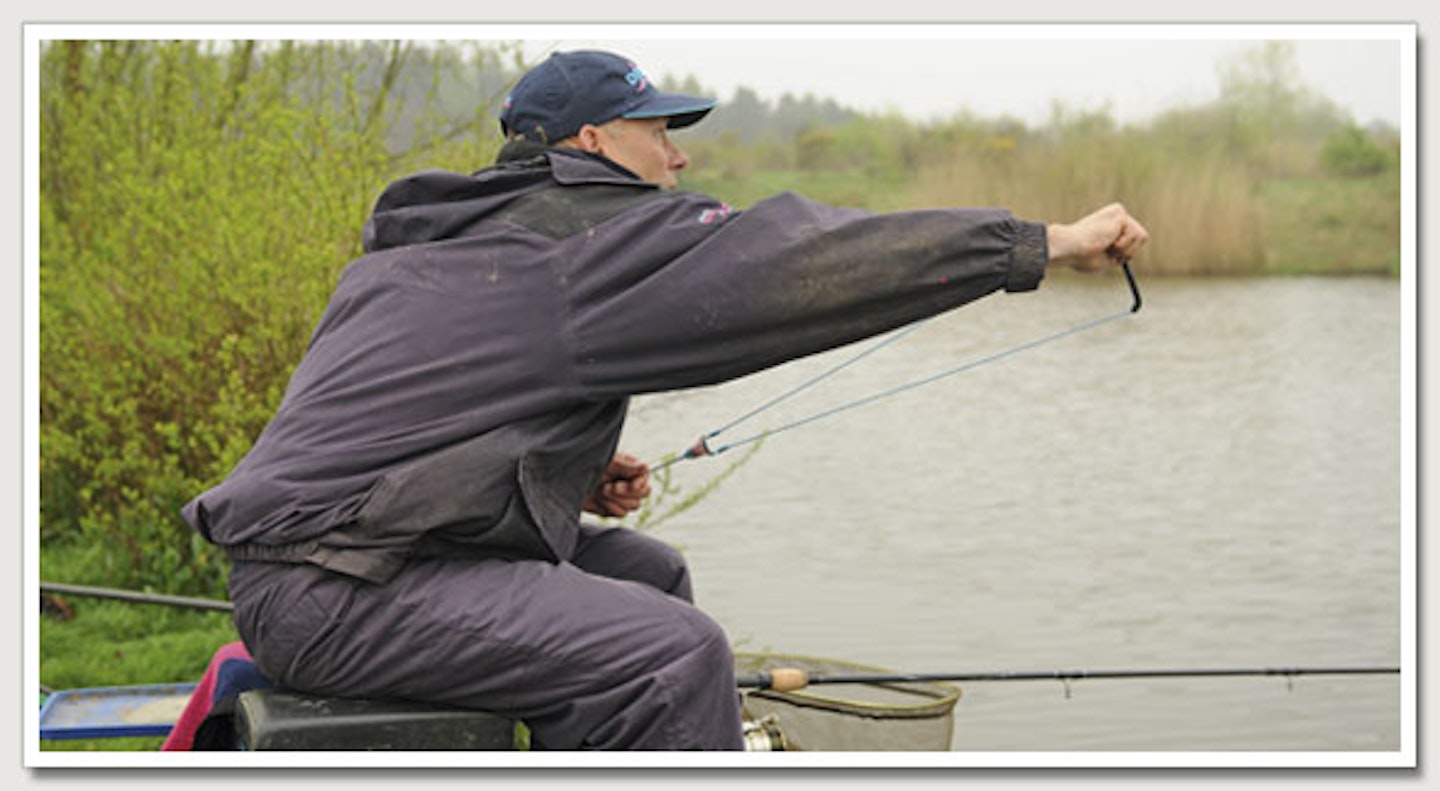
Floats
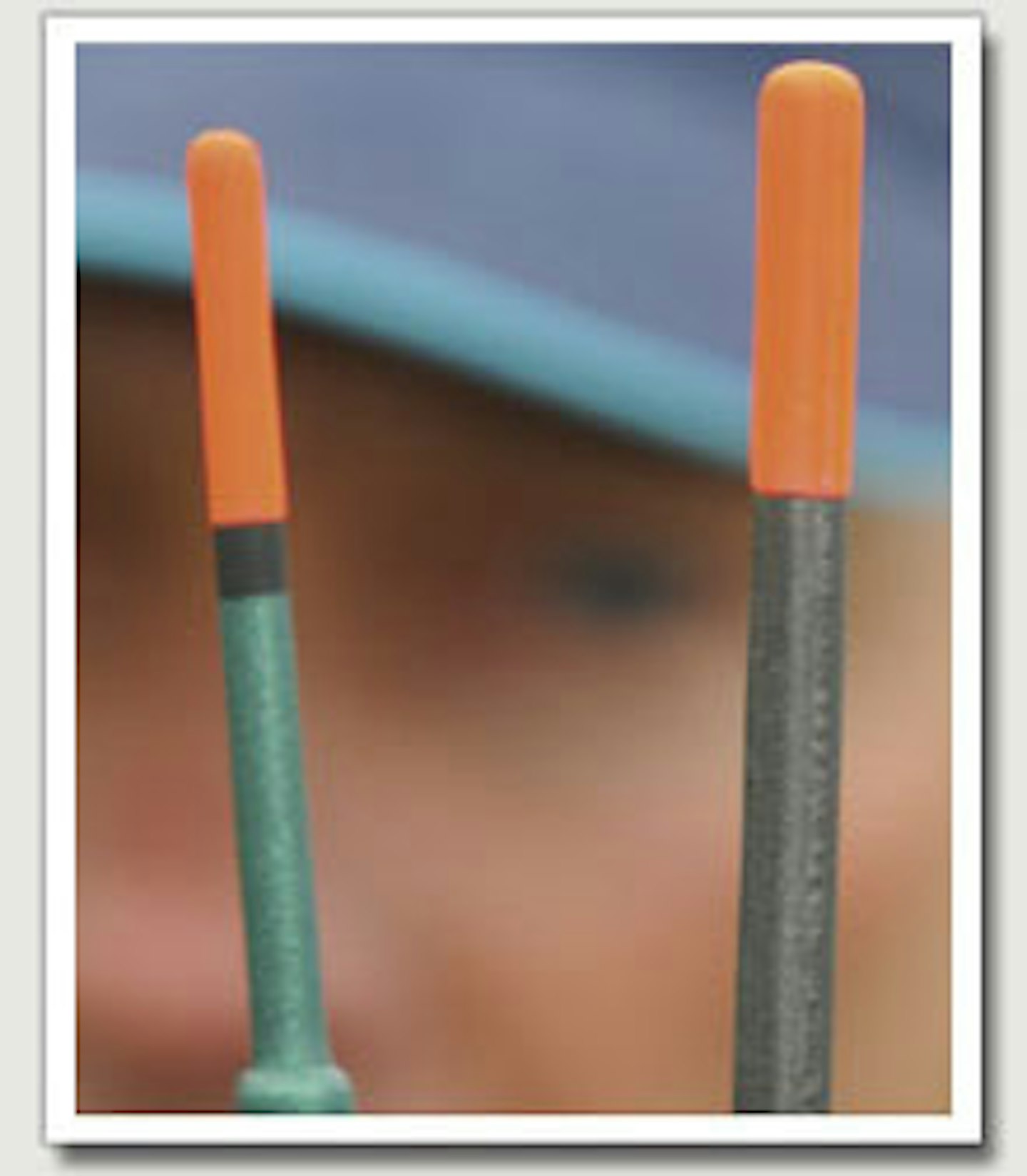
There are two main types of wagglers – ‘straight’ and ‘insert’. As the name suggests, ‘straight’ wagglers are made from a length of peacock quill (or other material) that’s the same diameter throughout.
‘Inserts’ have a slimmer length of cane or fibreglass inserted in the top of the peacock quill. This slimmer sight tip is much more sensitive and will emphasise shy bites much easier than the thick top of a ‘straight’ waggler.
Both types of floats come in loaded or unloaded versions, but Steve much prefers the unloaded version as he can move shot up and down the line to adjust the bait’s rate of fall, depending on where the fish are in the water table. He also reckons they cast straighter than loaded versions.
Bulk shot should always be locked around the base of the float with one shot above, and all the others below it, to help it fly straight and avoid tangles.
Waggler range
The ideal range to fish a waggler is between 20 yards and 30 yards.
The distance at which you fish will be limited by the range you can fire loosefeed.
The perfect all-round waggler for general fishing has a 3AAA(or 3AA) shot capacity.
Always try to fish with a slightly heavier waggler than you think you’ll need. Heavier floats are easier to cast and control. With a heavy float you can always cast beyond your target area and wind back. With lighter floats you may not be able to reach the target, especially if the wind picks up.
Float adaptors
Always attach your waggler to your reel line via a float adaptor. There are loads of different types, and they’re relatively cheap. This allows you to instantly change to a lighter or heavier waggler if wind and tow conditions change.
Hooklength
Always fish with a lighter hooklength than your mainline. That way, if you become snagged, and have to pull for a break, you’ll only loose the hooklength, but will get your float back.
Steve uses Drennan Double Strength hooklengths. The diameters he uses for particular sizes/species of fish are listed below.
0.10mm – roach and skimmers
0.12mm - bigger skimmers and tench
0.14mm - medium sized carp
0.16mm – big carp
Hooks
Don’t use fine wire hooks for waggler fishing – the metal is too springy and will cause hook pulls. Neither do you want heavy, forged carp hooks.
When using baits like maggot and caster, go for a ‘medium wire’ hook like Steve’s favourite Drennan Silverfish Maggot in a size 18. This is light enough not to drag the bait down unnaturally, yet strong enough to land bigger, bonus fish.
If fishing pellet, try a pattern like Drennan Wide Gape Pellet in size 16. The wider gape (distance between the hookpoint and shank) will increase the amount of successful hook-ups.
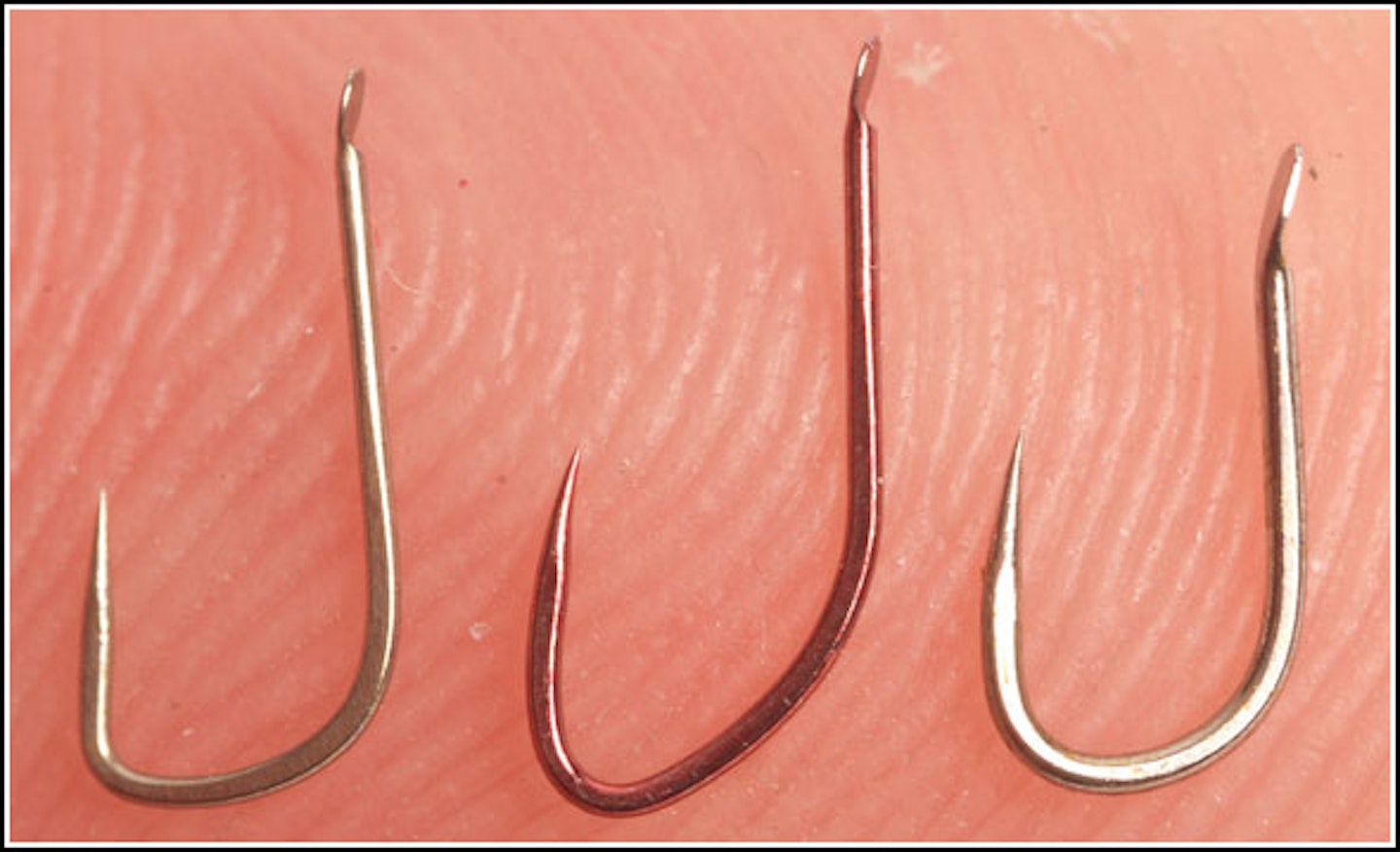
From left: Light, Medium and Heavy wire hooks
Swivels
Get hold of some micro swivels and tie one to the end of your reel line, then attach the hooklength to the swivel. This helps prevent baits like double maggot or caster spinning and twisting the hooklength. Micro swivels weigh about the same as a No 8 split shot, so it acts as a perfect dropper shot.
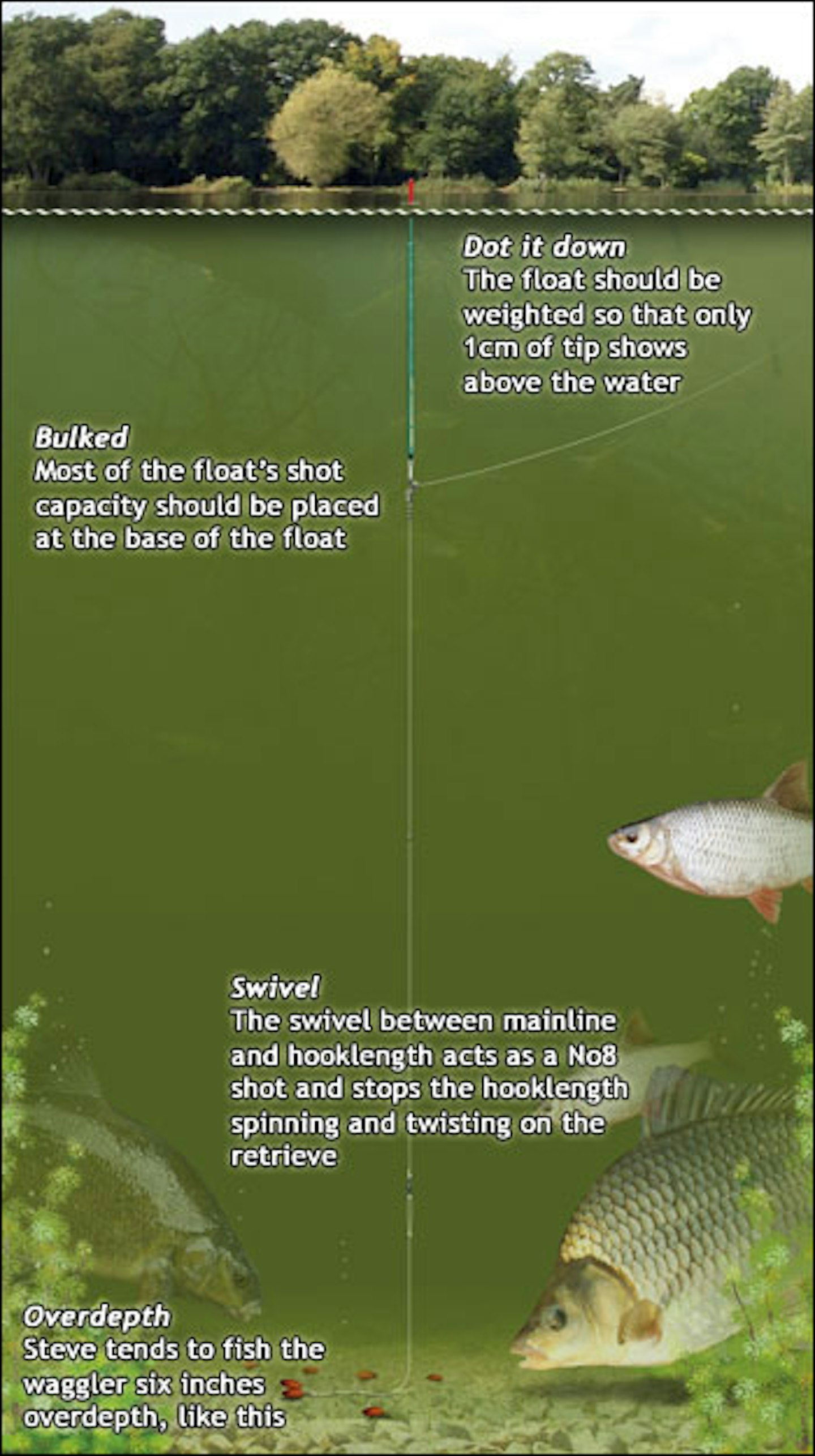
Depth and shotting patterns
Most modern commercial stillwaters are around 4ft to 6ft deep. These are ideal depths to fish a slow-sinking bait. Steve always kicks off by plumbing the exact depth of his swim and then adding six inches.
He fishes with all the large shot (the ‘bulk’ shot) around his float and two No8 shot down the line (one of these sinker ‘shot’ will be his micro swivel).
Applying shot
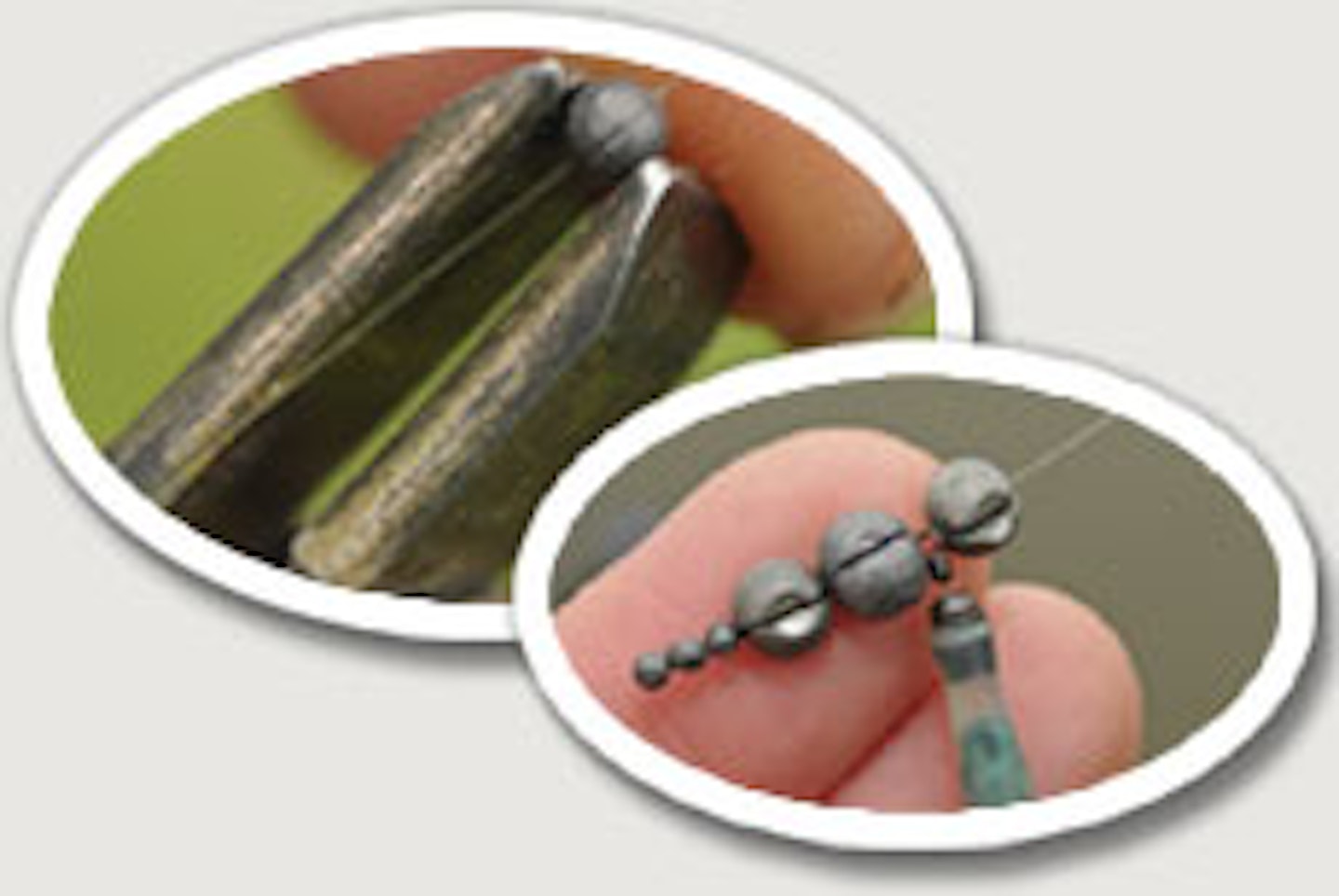
Use a pair of styl pincers to put small, No8 dropper shot on the line as you can control the pressure applied better than using teeth. Never use your teeth to nip on non-toxic locking shot around the float – the split shot’s sharp edges can easily damage the line. Squeeze these shot on using finger pressure only, or use a sleeve of silicone on the line to act as a buffer. Always use your nail to open the cut on larger split shot prior to moving, or removing them so you don’t damage the reel line.
Keep a few No8 shot with the main bulk so you have the option to push shot down the line to alter hookbait’s the rate of fall.
Float tip colours
Always carry a range of black, red, orange or yellow tipped wagglers to suit all light conditions. Use yellow and orange tips on dark, shaded water and black and red on water in full light/sunshine.
Carry a black permanent marker pen to darken floats with light coloured tips, or slide a ‘sleeve’ of tight-fitting black silicone over them if you don’t want to ruin the original paintwork.
In calm conditions, always ‘dot’ the float tip down so that only 1cm (less than half an inch) of sight tip shows. This way, you’ll spot really shy bites.
Bait
Single or double maggot or casters are superb waggler baits because they fall slowly and enticingly through the water, aided only by two No8 dropper shot.
If using caster a good trick is to use a floating caster (a very dark bait) and a sinker (a lighter brown/tan), to counterbalance the weight of the hook and further slow down the rate of fall.
Another good tip with caster is to experiment with colours. Some days, the fish will prefer darker colours, other times they may favour a cocktail of a light caster and a dark one.
.jpg?auto=format&w=1440&q=80)
Left: When fishing double caster put the first on the hook like this. Right: Add the second caster like this to stop them spinning like a propeller on the retrieve.
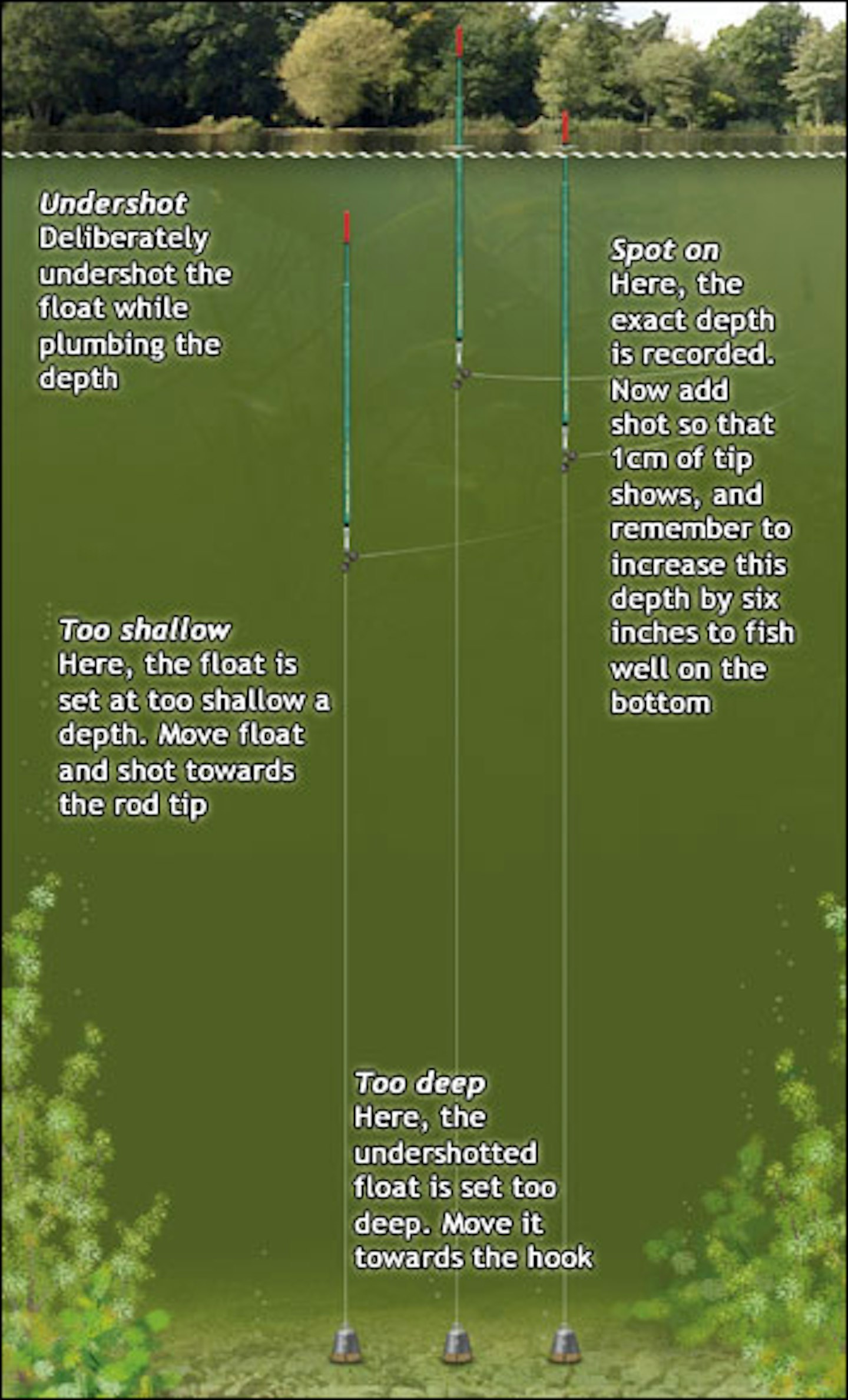
Plumbing the swim
The easiest way to plumb the swim is to use a 0.25oz plummet with an eye and cork bottom rim to nick the hook into. (Clip on plummets can easily damage fragile hooklengths.)
It is essential to use an undershotted float so it can rise to the surface easily. This way you don’t get any false readings.
If he’s using a 3AAAfloat, Steve always removes one of the AAAshot prior to plumbing up and replaces it after he’s found the depth.
Aslow, overhead cast will send the weight of the plummet flying straight out in front of the float and lay the rig out in a straight line, avoiding tangles.
Once he’s found the bottom, Steve nicks his hook in the rod ring nearest the butt and then uses a dab of pole float paint to mark the point where the tip of his waggler comes to on the rod blank – just like you would mark the depth on a pole. If his hooklength gets broken, or he loses his rig, he knows exactly how deep the swim is for tackling up again.
Once he’s established the exact depth, Steve automatically adds six inches. He reckons that, generally, the better fish like carp and bream will be on the deck.
Smaller species like roach and rudd tend to be further up in the water. These silver species often give lightning fast bites that are hard to hit. Fishing six inches overdepth gives fish like carp, tench and bream time to get the bait well in their mouths, providing very positive bites.
Casting
You must put your waggler in the same spot every time, so casting to a permanent, far bank marker like a tree or staging is a good idea.
In open water pick a distance to fish to and then add two metres of line and use the line clip on the reel to prevent any more line being taken off the spool.
The extra couple of meters will allow you to accomplish one of the most important parts of waggler fishing – sinking the line.
Sinking the line
As long as you are ‘clipped up’ and not trying to whack the float too far, the line will hit the clip and lay the rig out perfectly in a straight line on the cast, avoiding the risk of tangles.
The entire top section of the rod should immediately be pushed at a 30-degree angle into the water and two full turns of the handle be made to recover the extra two yards of line, while drawing the float back into the target area.
At the same time, Steve smartly flicks the tip of his rod straight up and out of the water. The combination of these actions snatches all the line between rod tip and float under the water’s natural surface tension. Job done!
Reel lines can become greasy, especially on waters where a lot of meat is fed regularly, making them very hard to sink. In this case, Steve carries a tiny bottle
of undiluted Fairy washing up liquid. He casts out, then puts two drops of the liquid between his forefinger and thumb and reels the line back in through his pinched fingers, coating the mono with the grease-busting liquid.
Feeding
Correct feeding is a major part of successful waggler fishing. Little and often is the general rule for smaller fish with half a dozen maggots or casters catapulted in every cast.
If you start getting plagued by small fish intercepting your hookbait up in the water in response to the stream of falling bait, try catapulting two large pouches of bait every second cast. This will push the fish back on the deck, where they’re easier to catch.
If you constantly get bites on-the-drop, try shallowing up as the fish may be sitting at mid-depth. You can always return to full depth, because you’ve marked it on your rod blank.
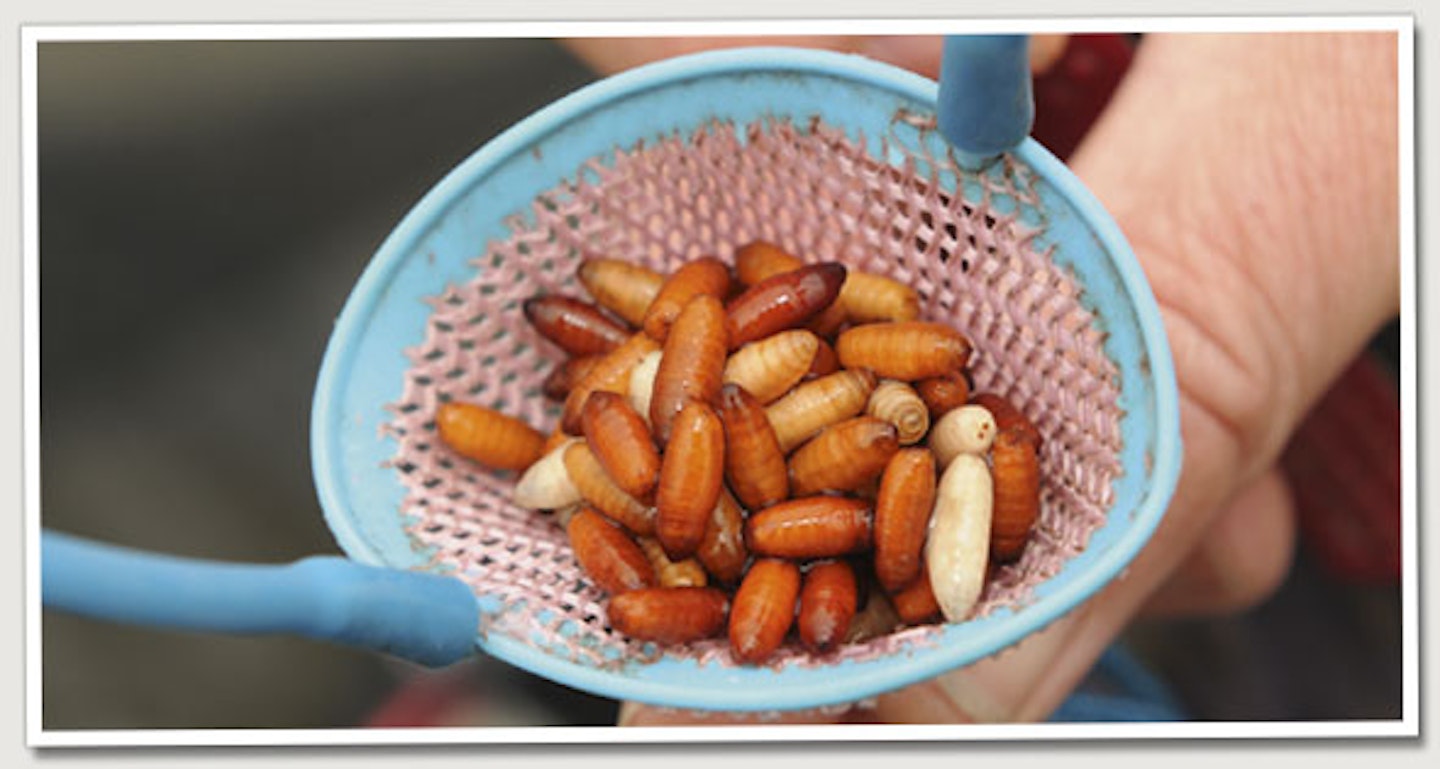
The session
On just the second cast at the prolific Packington Somers Fishery at Somers Road, Meriden, between Coventry and Birmingham, Steve opens his account when a 4oz roach intercepts his slowly falling caster hookbait, but it’s not what he’s after.
He suspects the larger fish are sitting on the bottom so two big pouches of casters are fired to the target area 25 yards out.
After two minutes the float nods twice, indicating that a fish is present, but Steve doesn’t strike. It’s not like pole fishing where you lift into every movement. You must discipline yourself to wait for the bite to fully develop. Five seconds later the float slides away, and stays under. These are the waggler bites you’re looking for.
A healthy bend in the rod shows this isn’t a roach and a couple of minutes later a 3lb mirror carp comes to the net.
With big, powerful fish, Steve keeps the rod tip down low all the way until the fish is within netting range. The fish tend to be calmer if you keep them low in the water. They normally go berserk when you get them high up in the water and they can see things. If your hooklink is on the verge of breaking, or the hook pulling, this is when it will happen.
Over the next two hours, more carp, tench and bream are taken off the bottom, along with the odd roach and rudd, before the swim dies. The sun has warmed the upper water layers by now and Steve suspects that the carp have come up in response.
.jpg?ar=16%3A9&fit=crop&crop=top&auto=format&w=1440&q=80)